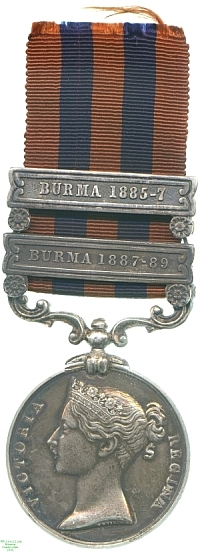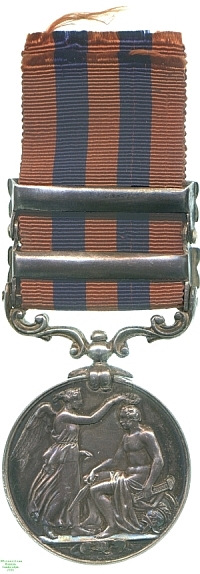
Obverse, a bust of Queen Victoria

Reverse, Victory crowning a seated Classical warrior with a laurel wreath

Obverse, a bust of Queen Victoria |

Reverse, Victory crowning a seated Classical warrior with a laurel wreath |
The Army of India Medal's issue in 1849 having marked the previous half-century's combats in the region, further conflicts in the 1850s led in 1854 to the design and issue of a General Service Medal for the theatre, for which bars would be issued as each new campaign merited.
Diplomatic relations between the Burmese Kingdom of Ava, in and beyond modern-day Myanmar, and the British in India deteriorated during a Burmese succession crisis in 1879, and increasing Burmese dealings with French interests led to confrontation over border issues by the British. Corresponding Burmese sanctions against British trade interests led to an ultimatum and finally war in 1885.
The British, having learnt from the difficult jungle warfare of previous campaigns in Burma, chose this time to move directly on the Burmese capital by means of the River Irrawaddy (Ayeyarwady), and the advance was so rapid that Burmese resistance was entirely uncoordinated. Burmese court divisions further weakened their deployment, and King Thibaw of Ava was taken prisoner in Mandalay a mere fortnight after war had been declared. Many of the Burmese forces were however only now massing, and in the absence of leadership took to the country to mount guerilla campaigns against what was now the annexation of Ava and its Burmese territories to British India. British campaigns against such insurgents continued until 1892, and bars were awarded to the India General Service Medal for them in 1889 and 1892.
This medal, which bears bars for the initial campaign of annexation and the first two years of fighting against the resistance, was awarded to Private J. Stockton of the 1st Rifle Brigade. Lester Watson purchased it at some point before 1928.